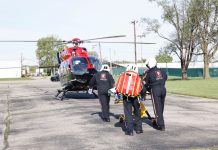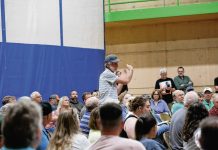The pedestrian crossing over Haw Creek in Columbus — a project years in the making — has opened for walking, jogging or bicycling after a series of delays.
Barricades were removed late last week from the newly refurbished old Newbern Bridge almost five months after the historic structure was placed in position south of the 25th Street bridge.
A post-opening ribbon-cutting ceremony is expected to be scheduled in the next two to three weeks, Columbus Parks director Mark Jones said.
After three cranes hoisted the structure into place over Haw Creek on Sept. 7, local officials expressed optimism about an official opening six weeks later.
[sc:text-divider text-divider-title=”Story continues below gallery” ]
However, manufacturing problems involving a subcontractor hired to construct specialty railings resulted in long and unanticipated delays, Jones said.
Unexpected obstacles involving the old Newbern Bridge have reached almost a legendary status among county officials and contractors.
As historic bridge consultant D. Eric Brunn put it last year, it’s the only local project that took three decades spanning two millenniums to complete.
Bridge history
In 1999, the Bartholomew County commissioners voted to close the deteriorating one-lane, iron-truss bridge along County Road 850E in the eastern part of the county.
Initially, efforts were undertaken to move the historic structure to Anderson Falls Park, but that idea was eventually dropped in favor of the People Trail in Columbus.
The first big delay came in 2001, when archaeologists uncovered more than 350 artifacts at the site. More than $100,000 in local tax money was spent to carefully excavate the area, remove the artifacts and to document them.
But without that investment of time and money, the county risked losing federal funds to build a new bridge, as well as a $584,000 state grant to refurbish the existing one, county commissioner Larry Kleinhenz said.
After being forced to file extensive paperwork on the structure’s historic status, the county was then required to spend thousands of dollars for redesign work and soil tests required to keep the federal grants.
Further delays came when the county went to court in 2012 to establish who owned five parcels of needed property near Clifty Creek.
Later that same year, the state pulled its reconstruction grant because delays made transportation officials believe the county was never going to spend the money. It took more than a year of lobbying before the grant was restored in January 2014.
It took 16 years after the commissioners determined the old bridge had to go before the old bridge finally went.
Three cranes lifted the historic structure from its foundations near the Newbern United Methodist Church in February 2015. The replacement bridge was installed in less than a year.
After the old bridge was completely disassembled, each piece was transported to a northern Indiana metal shop, Brunn said.
New parts were substituted for pieces that could not be salvaged, said Brunn, who works for the Columbus-based engineering consulting firm Strand Associates.
Old rivets were taken out, new bolts were put in, and rusted joints were replaced, county highway engineer Danny Hollander said.
Despite the extensive amount of work, Hollander estimates about 95 percent of the original bridge remains.
New home
Last spring, workers began to reassemble all the pieces on the east bank of Haw Creek in Columbus. The now-bright-red structure was finally moved into place shortly after Labor Day weekend.
Pre-assembled wood decking was then placed on the structure, while permanent foundation attachments were made, Jones said.
While long-term bridge maintenance is now the responsibility of the city of Columbus, Jones says it’s worth the expense.
It will provide bicyclists and pedestrians safe passage across the river without having to dealing with traffic on busy 25th Street or National Road, he said.
Additionally, organizers of the Mill Race Marathon, conducted each September, will consider whether to incorporate the bridge into the running courses, Jones said.
[sc:pullout-title pullout-title=”Newbern Bridge timeline” ][sc:pullout-text-begin]
1910: Original bridge constructed over Clifty Creek along County Road 850N on the northwest side of Newbern. Originally built for trains, the bridge was later modified for vehicular traffic.
1982: Bridge reconstructed.
1999: Bartholomew County Commissioners vote to replace the aging bridge and $960,000 in federal funding is acquired for the project.
2001: Archaeologists uncover more than 350 artifacts under Clifty Creek at the site. Replacement is delayed.
2003: Despite concerns over deterioration, the 12-ton weight limit for the Newbern Bridge is maintained.
2004: Indiana first lady Nancy Kernan announces Bartholomew County will receive a $584,000 state grant to refurbish the existing Newbern bridge once it is replaced.
2005: Amount set aside for construction of a new Newbern Bridge rises to $1.25 million.
2010: Proposal emerges that the old bridge could be used as part of the Columbus People Trails, spanning Haw Creek south of 25th Street.
2012: Due to delays, the 2004 grant for the reconstruction project over Haw Creek is dropped by the state.
2013: Both city and county leaders lobby the state Department of Transportation to restore reconstruction funds.
2014: The transportation department agrees to restore funding in January. A determination is made to close the 104-year-old bridge the first full week of November.
2015: Historic Newbern Bridge taken apart, transported on flatbed trucks to Lincoln Park in Columbus, where it will be stored prior to restoration.
2016: County approves funds needed to restore the bridge for use as a pedestrian path.
2017: The bridge is reassembled on the east side of the river over several months and finally placed in position over Haw Creek on Sept. 7. Delays in obtaining specialty railings keeps the crossing closed for several months.
2018: Barricades are removed Feb. 1 that allow the 108-year-old bridge to become part of a new Columbus People Trail extension.
[sc:pullout-text-end]




